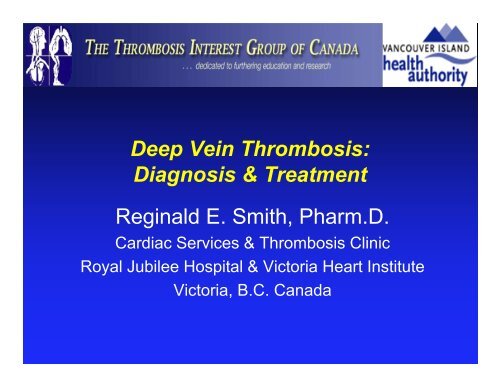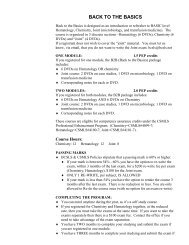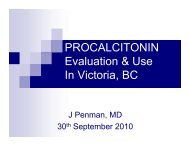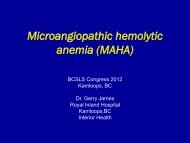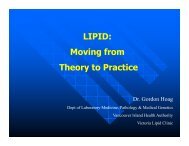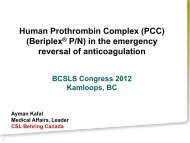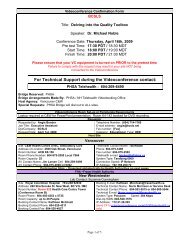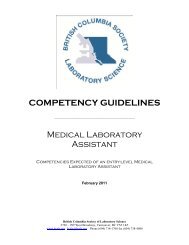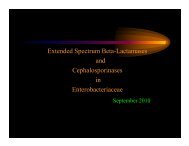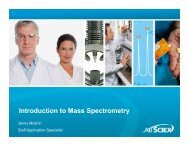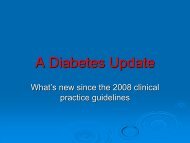Deep Vein Thrombosis: Diagnosis & Treatment Reginald E. Smith ...
Deep Vein Thrombosis: Diagnosis & Treatment Reginald E. Smith ...
Deep Vein Thrombosis: Diagnosis & Treatment Reginald E. Smith ...
Create successful ePaper yourself
Turn your PDF publications into a flip-book with our unique Google optimized e-Paper software.
<strong>Deep</strong> <strong>Vein</strong> <strong>Thrombosis</strong>:<br />
<strong>Diagnosis</strong> & <strong>Treatment</strong><br />
<strong>Reginald</strong> E. <strong>Smith</strong>, Pharm.D.<br />
Cardiac Services & <strong>Thrombosis</strong> Clinic<br />
Royal Jubilee Hospital & Victoria Heart Institute<br />
Victoria, B.C. Canada
Outline<br />
VTE: <strong>Diagnosis</strong> & <strong>Treatment</strong><br />
VTE Pathophysiology & Background<br />
<strong>Diagnosis</strong> of DVT (D-Dimer/Ultrasound)<br />
<strong>Diagnosis</strong> of Pulmonary Embolism<br />
Post Thrombotic Syndrome<br />
Pharmacological <strong>Treatment</strong> of DVT/PE<br />
Cancer & VTE<br />
New Antithrombotics<br />
13:30 hrs<br />
2
Fail or Win<br />
3
Child Safety Fail<br />
4
Virchow’s Triad and Thrombus Formation<br />
Described by Rudolf Virchow 150<br />
years ago<br />
<br />
Vascular Injury, Hypercoaguability,<br />
Venous Stasis<br />
<br />
One or more of these components<br />
is present in the majority of<br />
patients with thrombosis<br />
Virchow’s<br />
Triad<br />
Venous Stasis<br />
Adapted from Joist JH. Semin Thromb Hemost. 1990;16:151-157.<br />
6<br />
6
Associated Conditions<br />
<br />
Surgery – Particulary Orthopedic of<br />
Lower Limbs, Abdomen, Pelvis<br />
<br />
Cancer – Known Cancer, Or Can Be<br />
The First Sign Of Occult Cancer<br />
<br />
Hereditary Or Acquired Thrombophilia<br />
<br />
Travel (Air or Long Distance Auto)<br />
<br />
Pregnancy, Estrogens<br />
Adapted from Joist JH. Semin Thromb Hemost. 1990;16:151-157.<br />
7<br />
7
Pathophysiology of DVT<br />
Most Often In <strong>Deep</strong> <strong>Vein</strong>s Of<br />
Leg or Calf<br />
Embolus<br />
Thrombus<br />
Venous<br />
valve<br />
Also Occurs In Arms, Thorax<br />
(Subclavian), Hepatic Portal,<br />
Messenteric, and Pelvic <strong>Vein</strong>s<br />
Pressure Increases In <strong>Vein</strong>s<br />
Below Thrombus<br />
DVT=deep vein thrombosis<br />
1. Hirsh J, Hoak J. Circulation. 1996;93:2212-2245.<br />
2. Figure from Tapson VF. N Engl J Med. 2008;358:1037-1052. Copyright ©2008 Massachusetts Medical Society. All rights reserved.<br />
8<br />
8
Patients are at Risk for DVT Across<br />
a Broad Range of Hospital Settings<br />
DVT=deep vein thrombosis<br />
Geerts WH et al. Chest. 2004;126(3 Suppl):338S-400S.<br />
9<br />
9
Late Presentation Is Common<br />
The Risk Continues Post- Discharge<br />
TKR<br />
1 month<br />
THR<br />
3 months<br />
White R.H., et al. Arch Intern Ned 1998; 158:1525-1531.<br />
N=43,645<br />
11
Symptoms of DVT<br />
• Leg pain (90%)<br />
• Tenderness (85%)<br />
• Ankle edema (76%)<br />
• Calf swelling (42%)<br />
• Dilated veins (33%)<br />
• Dusky discoloration (30%)<br />
• Warmth<br />
50% NO SYMPTOMS<br />
Symptomatic DVT<br />
“DVT cannot be reliably diagnosed on the basis of<br />
history and physical exam, even in high-risk patients”
WELLS Scale For Pretest Probability<br />
Score<br />
-2 to 0 Low Pretest Probability<br />
1 or 2 Moderate Pretest Probability<br />
> 2 High Pretest Probability
Diagnostic algorithm using D-dimer testing and<br />
ultrasound imaging in patients with suspected DVT<br />
Scarvelis & Wells, 2006<br />
14 1<br />
4<br />
14
Sensitivity & Specificity Of D-Dimer<br />
Test For <strong>Deep</strong> <strong>Vein</strong> <strong>Thrombosis</strong><br />
Subgroup Sensitivity Specificity Negative<br />
Predictive Value<br />
Low or<br />
Moderate<br />
Pretest<br />
Probability<br />
High Pretest<br />
Probability<br />
Patients With<br />
Cancer<br />
97.1% 62.7% 99.6%<br />
100% 40% 100%<br />
100% 45.5% 100%<br />
D-Dimer False Positive With Surgery, Injury, Infection, Cancer, Pregnancy<br />
Bates, S. M. et. al. Ann Intern Med 2003;138:787-794
Compression Ultrasound Lower Extremity:<br />
<strong>Deep</strong> <strong>Vein</strong>s
Compression Ultrasound<br />
Lower Extremity: <strong>Deep</strong> <strong>Vein</strong>s<br />
No DVT<br />
Superficial Femoral <strong>Vein</strong><br />
Normal Compression – No DVT<br />
Superficial Femoral <strong>Vein</strong><br />
<strong>Vein</strong> Does Not Compress - DVT
Venous Anatomy Of The Leg<br />
Proximal<br />
DVT<br />
<strong>Thrombosis</strong> in<br />
Trifurcation<br />
or Higher
<strong>Deep</strong> <strong>Vein</strong> Clots Are Big<br />
Measured In Centimeters<br />
Measured In Millimeters<br />
VS<br />
DVT Clots Can Be As Round As Your<br />
Finger And As Long As Your Leg<br />
Coronary Clots Very Small
Washing Instructions -- FAIL<br />
20
Pulmonary Embolism<br />
21
Pulmonary Embolism<br />
<br />
<br />
<br />
<br />
Shortness of breath<br />
Pleuretic Chest + Rib Pain<br />
(worsens with breathing)<br />
Bloody sputum<br />
Dyspena, Fatigue<br />
LA=left atrium; LV=left ventricle; PE=pulmonary embolism; RA=right atrium; RV=right ventricle<br />
Figure from Tapson VF. N Engl J Med. 2008;358:1037-1052.<br />
Copyright ©2008 Massachusetts Medical Society. All rights reserved.<br />
22<br />
22
Pulmonary Embolism:<br />
A Life-threatening Disease<br />
Cumulative mortality following acute PE<br />
Mortality rate (%; excluding PE<br />
first recognised at necropsy)<br />
16<br />
14<br />
12<br />
10<br />
8<br />
6<br />
4<br />
2<br />
0<br />
15.3% Mortality<br />
At 3 months<br />
International Cooperative Pulmonary<br />
Embolism Registry<br />
N=2454<br />
0 10 20 30 40 50 60 70 80 90<br />
Time from diagnosis (days)<br />
PE=pulmonary embolism<br />
Goldhaber SZ et al; for ICOPER. Lancet. 1999;353:1386–1389.<br />
23 2<br />
3<br />
23
Wells Scoring System for Diagnosing<br />
Pulmonary Embolism<br />
High Probability 7 or Higher<br />
Intermediate 2 to 6 PE Is Likely If Score > 4<br />
Low Probability Less Than 2<br />
DVT=deep vein thrombosis; PE=pulmonary embolism<br />
Lee CH et al. Med J Aust. 2005;182:569-574.<br />
24 2<br />
4<br />
24
Diagnostic Testing for PE<br />
CT Angiography<br />
Coronal Axis<br />
Saggital Axis
Heart Sounds<br />
S1 = Tricuspid + Mitral<br />
S2 = Pulmonic + Aortic<br />
Massive Pulmonary Embolism Can Produce A Split S2
Acute Pulmonary Embolism<br />
R Axis Deviation<br />
T Wave Inversion<br />
Q Wave in III<br />
S1 Q3 T3 – Pattern<br />
ST Depression In Anterior Leads Also Possible
Post Thrombotic Syndrome<br />
Develops in<br />
Half of<br />
Patients<br />
at two<br />
years 1
Grade IA<br />
Symptomatic Proximal DVT<br />
Gradient 30-40 mmHg Minimum 2 Years, Longer if PTS<br />
(40-50% Reduction in PTS)<br />
Elastic Bandages Can Be Applied<br />
Initially<br />
GCS Fitting Once Acute Swelling<br />
Has Subsided
<strong>Treatment</strong> of <strong>Deep</strong><br />
<strong>Vein</strong> <strong>Thrombosis</strong> &<br />
Pulmonary Embolism<br />
31
Therapy: Do We Need To Anticoagulate<br />
Patients With Acute VTE ?<br />
<br />
19 Patients With PE Randomized To No Therapy<br />
<br />
16 Patients Wit PE Randomized toHeparin 10,000 U SQ<br />
Q6H x 6 Doses Then Oral Anticoagulation x 2 Weeks<br />
Group<br />
Mortality<br />
No Therapy 26.3%<br />
Heparin/ 0%<br />
Oral Anticoag<br />
ARR= 26.3% NNT 3.8<br />
Barrett and Jordan, Lancet 1960:1:1309<br />
32
Do You Need A Fast Acting<br />
Anticoagulant Up Front ?<br />
patients with objectively proven acute lower-limb DVT<br />
randomized trial of IV standard heparin + oral<br />
anticoagulants or oral anticoagulants alone<br />
Symptomatic<br />
Recurrences<br />
Asymptomatic<br />
Recurrences<br />
All<br />
Recurrences<br />
OAC alone<br />
Heparin + OAC<br />
12 / 60 39.6 %<br />
4 / 60 8.2 %<br />
58.3 %<br />
13 %<br />
ARR = 45% NNT = 2.2<br />
Brandjes et al. NEJM 1992:327;1485<br />
33
Overlapping Heparins, LMWH or<br />
Fondaparinux With Warfarin<br />
II<br />
Longest<br />
T1/2<br />
VII<br />
Shortest<br />
T1/2<br />
Factor II Depleted<br />
By Day 5<br />
Heparin/LMWH or Fondaparinux Minimum 5 Days<br />
Continue Until At Least 2 Sequential INRs In Range (2-3)<br />
LMWH Anti-Inflammatory: May Continue > 10 Days For Extensive DVT<br />
34
Heparin Induced Skin Necrosis<br />
Patient May Be Developing Heparin Induced Thrombocytopenia & <strong>Thrombosis</strong><br />
Stop Heparins Immediately – Check For HIT Antibodies<br />
Start Argatroban Infusion<br />
35
Does SYMPTOMATIC Calf DVT Require <strong>Treatment</strong> ?<br />
Calf DVT, treated initially with intravenous UFH<br />
then long term therapy OAC vs no treatment<br />
Recurrence during<br />
first 3 months<br />
Recurrence during<br />
first year<br />
OAC<br />
No Rx<br />
0 / 23 (0%) 1 / 23<br />
8 / 28 (28.5%) 9 / 28<br />
Recurrence 3 Months: <strong>Treatment</strong> vs No <strong>Treatment</strong> ARR=28.5% NNT= 3.5<br />
Lagerstedt Lancet 1985:2;515<br />
36
<strong>Treatment</strong> of DVT/PE<br />
Recommendations from 8th ACCP Guidelines<br />
First-episode secondary to transient risk factor<br />
Warfarin for 3 months<br />
First-episode idiopathic<br />
Warfarin for at least 3 months;<br />
Long-term therapy based upon risk-benefit ratio<br />
Antiphospholipid antibodies or ≥2 thrombophilic<br />
conditions<br />
Treat for 12 months; consider indefinite<br />
anticoagulant therapy<br />
First episode with deficiency of antithrombin III,<br />
protein C or S, factor V Leiden or prothrombin<br />
20210 gene mutation, hyperhomocysteinemia, or<br />
high factor VIII levels<br />
Treat for 6 to 12 months; indefinite therapy for<br />
patients with idiopathic thrombosis<br />
≥2 episodes<br />
Indefinite treatment<br />
Kearon C, et al. Chest 2008;133;454S-545S<br />
37
Cancer Associated <strong>Thrombosis</strong><br />
38
Cancer & VTE<br />
39
<strong>Treatment</strong> Of Cancer Associated<br />
<strong>Thrombosis</strong><br />
Chest Guidelines 2008: LMWH First 3-6 Months Then LMWH or Warfarin Until Cancer In Remission<br />
40
Slogan -- FAIL<br />
41
Novel Anticoagulants:<br />
The Future of Warfarin<br />
<strong>Reginald</strong> E. <strong>Smith</strong>, Pharm.D.<br />
Cardiac Services & <strong>Thrombosis</strong> Clinic<br />
Royal Jubilee Hospital & Victoria Heart Institute<br />
Victoria, B.C. Canada<br />
42
Current Limitations of Existing Drugs<br />
UFH<br />
LMWH<br />
VKAs<br />
Limitations<br />
► Parenteral<br />
► Unpredictable due to<br />
unspecific binding<br />
► Risk of HIT<br />
► Parenteral<br />
► Risk of HIT<br />
► Unpredictable<br />
► Slow onset of action<br />
► Narrow therapeutic window<br />
► Food and drug interactions<br />
Consequences<br />
► Inconvenient for<br />
long term use<br />
► Monitoring of<br />
aPTT required<br />
► Inconvenient and<br />
expensive for long term<br />
use<br />
► Monitoring of platelets<br />
► Regular monitoring and<br />
dose adjustments<br />
► Risk of adverse events<br />
(bleeding)<br />
Fondaparinux<br />
► Parenteral ► Inconvenient and<br />
expensive for long term<br />
use<br />
Lassen MR. Vasc Health Risk Manag. 2008;4(6):1373-86.
New Oral Anticoagulant Agents In<br />
Development<br />
Heparin<br />
LMWH<br />
Fondaparinux<br />
Idraparinux<br />
Semuloparin<br />
Antithrombin III<br />
X<br />
TF/VIIa<br />
VIIIa<br />
Xa<br />
II<br />
Va<br />
IXa<br />
IX<br />
TTP889<br />
Rivaroxaban<br />
Apixaban<br />
LY517717<br />
YM150<br />
DU-176b<br />
Betrixaban<br />
Dabigatran<br />
IIa<br />
Fibrinogen<br />
Fibrin<br />
Adapted from Turpie Eur Heart J 2008
Dabigatran
Dabigatran etexilate:<br />
a novel direct thrombin inhibitor<br />
N<br />
N<br />
CH 3<br />
N<br />
N<br />
NH<br />
H 3<br />
C<br />
O<br />
O<br />
O<br />
O<br />
N H 2<br />
N<br />
O CH 3<br />
Half life of 12-17 h<br />
~ 80% renally excreted & 6.5% bioavailability<br />
Predictable and consistent anticoagulant effects<br />
Low potential for drug-drug interactions (Verapamil Increases Effect),<br />
no drug-food interactions<br />
No requirement for routine coagulation monitoring<br />
Rapid onset of action (1-4 hrs)
The RE-LY ® Study:<br />
Randomized Evaluation of<br />
Long-term anticoagulant therapY<br />
Dabigatran Compared to Warfarin in 18,113 Patients with<br />
Atrial Fibrillation at Risk of Stroke<br />
Connolly SJ., et al. NEJM published online on Aug 30th 2009.<br />
DOI 10.1056/NEJMoa0905561<br />
Dabigatran etexilate is in clinical development and not licensed for<br />
clinical use in stroke prevention for patients with atrial fibrillation
RE-LY ® – study design<br />
Atrial fibrillation with ≥ 1 risk factor<br />
Absence of contraindications<br />
R<br />
Warfarin<br />
1 mg, 3 mg, 5 mg<br />
(INR 2.0-3.0)<br />
N=6000<br />
Dabigatran etexilate<br />
110 mg bid<br />
N=6000<br />
Dabigatran etexilate<br />
150 mg bid<br />
N=6000<br />
Primary objective: To establish the non-inferiority of dabigatran etexilate to warfarin<br />
Minimum 1 year follow-up, maximum of 3 years and mean of 2 years of follow-up<br />
Ezekowitz MD, et al. Am Heart J 2009;157:805-10.<br />
Connolly SJ., et al. NEJM published online on Aug 30th 2009.<br />
DOI 10.1056/NEJMoa0905561<br />
Dabigatran etexilate is in clinical development and not licensed for<br />
clinical use in stroke prevention for patients with atrial fibrillation
Time to first stroke / SSE<br />
Cumulative hazard rates<br />
0.05<br />
0.04<br />
0.03<br />
0.02<br />
0.01<br />
Warfarin<br />
Dabigatran etexilate 110 mg<br />
Dabigatran etexilate 150 mg<br />
RR 0.91<br />
(95% CI: 0.74–1.11)<br />
p
Major bleeding rates<br />
3.50<br />
3.00<br />
2.50<br />
RR 0.80 (95% CI: 0.69–0.93)<br />
2.71<br />
p=0.003 (sup)<br />
RRR<br />
20%<br />
RR 0.93 (95% CI: 0.81–1.07)<br />
3.11<br />
p=0.31 (sup)<br />
3.36<br />
% per year<br />
2.00<br />
1.50<br />
1.00<br />
0.50<br />
0.00<br />
D110 mg BID D150 mg BID Warfarin<br />
Connolly SJ., et al. NEJM published online on Aug 30th 2009.<br />
DOI 10.1056/NEJMoa0905561<br />
322 / 6,015 375 / 6,076 397 / 6,022<br />
Dabigatran etexilate is in clinical development and not licensed for<br />
clinical use in stroke prevention for patients with atrial fibrillation
Intra-cranial bleeding rates<br />
90<br />
80<br />
70<br />
RR 0.31 (95% CI: 0.20–0.47)<br />
p
Most common adverse events<br />
Dabigatran<br />
110 mg<br />
%<br />
Dabigatran<br />
150 mg<br />
%<br />
Warfarin<br />
%<br />
Dyspepsia* 11.8 11.3 5.8<br />
Dyspnea 9.3 9.5 9.7<br />
Dizziness 8.1 8.3 9.4<br />
Peripheral edema 7.9 7.9 7.8<br />
Fatigue 6.6 6.6 6.2<br />
Cough 5.7 5.7 6.0<br />
Chest pain 5.2 6.2 5.9<br />
Arthralgia 4.5 5.5 5.7<br />
Back pain 5.3 5.2 5.6<br />
Nasopharyngitis 5.6 5.4 5.6<br />
Diarrhea 6.3 6.5 5.7<br />
Urinary tract infection 4.5 4.8 5.6<br />
Upper respiratory tract infection 4.8 4.7 5.2<br />
*Occurred more commonly on dabigatran p
A phase III, randomised, double blind, parallel-group<br />
study of the efficacy and safety of oral dabigatran<br />
etexilate (150 mg bid) compared to warfarin (INR 2.0–<br />
3.0) for 6 month treatment of acute symptomatic venous<br />
thromboembolism, following initial treatment (5–10<br />
days) with a parenteral anticoagulant approved for this<br />
indication.<br />
Dabigatran etexilate is in clinical development and<br />
not licensed for clinical use for acute treatment of VTE
RE-COVER TM Trial Design<br />
Singledummy<br />
period<br />
Double-dummy period<br />
Warfarin<br />
placebo<br />
Dabigatran etexilate 150 mg bid<br />
Objective<br />
confirmation<br />
of VTE<br />
72 h<br />
Warfarin<br />
Initial parenteral<br />
therapy<br />
Warfarin placebo<br />
Dabigatran etexilate placebo bid<br />
Warfarin<br />
(INR 2.0–3.0)<br />
30 days<br />
follow up<br />
E R<br />
E= enrolment<br />
R= randomization<br />
Until INR ≥2.0 at<br />
two consecutive<br />
measurements<br />
(8-11 days)<br />
6 months<br />
End of treatment<br />
54
Cumulative risk of recurrent VTE<br />
and related death<br />
Dabigatran<br />
Warfarin<br />
No. at risk<br />
Months Since Randomization<br />
Dabigatran was non-inferior to warfarin for prevention of recurrent or fatal VTE<br />
(P
Cumulative risk of first event of<br />
major bleeding and of any bleeding<br />
Warfarin, any bleeding<br />
Dabigatran, any bleeding<br />
Warfarin, MBE<br />
Dabigatran, MBE<br />
Warfarin and any bleeding<br />
29% RRR<br />
Dabigatran and<br />
any bleeding<br />
Dabigatran and<br />
major bleeding<br />
Warfarin and<br />
major bleeding<br />
Months since First Intake of Study Drug<br />
The hazard ratio for any bleeding at 6 months is 0.71 (95% CI, 0.59–0.85) in<br />
favor of dabigatran (P=0.0002).<br />
56
Most common Adverse Events<br />
<strong>Treatment</strong> period Only oral treatment Parenteral / oral treatment<br />
Dabigatran<br />
n = 1226<br />
Warfarin<br />
n = 1214<br />
Dabigatran<br />
n = 1273<br />
Warfarin<br />
n = 1266<br />
Headache (%) 60 (4.9) 64 (5.3) 79 (6.2) 88 (7.0)<br />
Pain in extremity (%) 59 (4.8) 69 (5.7) 64 (5.0) 71 (5.6)<br />
Nausea (%) 43 (3.5) 43 (3.5) 49 (3.8) 58 (4.6)<br />
Diarrhea (%) 46 (3.8) 34 (2.8) 57 (4.5) 38 (3.0)<br />
Nasopharyngitis (%) 47 (3.8) 53 (4.4) 50 (3.9) 54 (4.3)<br />
Dyspnea (%) 33 (2.7) 47 (3.9) 41 (3.2) 53 (4.2)<br />
Back pain (%) 42 (3.4) 44 (3.6) 46 (3.6) 50 (3.9)<br />
Arthralgia (%) 45 (3.7) 30 (2.5) 48 (3.8) 33 (2.6)<br />
Peripheral edema (%) 41 (3.3) 45 (3.7) 43 (3.4) 48 (3.8)<br />
Dyspepsia (%) 36 (2.9) 7 (0.6) 39 (3.1) 9 (0.7)*<br />
*p
Dabigatran: How To Measure Effect?
Thrombin Time Ratio Best<br />
Approximates Dabigatran Plasma Levels<br />
INR Poor Indicator of Dabigatran Effect
Bleeding Management<br />
Withhold Dabigatran/Rivaroxaban<br />
5 Half Lives<br />
2.5-3.5 days for Dabigatran,<br />
1.8 – 2.5 Days Rivaroxaban)<br />
Blood Transfusion<br />
Medical/Surgical Measures
Rivaroxaban
Rivaroxaban<br />
Brand name Xarelto ® , Bayer<br />
High oral bioavailability<br />
(>80%)<br />
Onset of action 2-4 hours<br />
Half-life 9-12 hours<br />
Prophylactic Dose 10 mg qd<br />
<strong>Treatment</strong> Dose 20 mg daily<br />
Primarily renal elimination<br />
(66%), remainder feces p<br />
glycoprotein<br />
No laboratory monitoring<br />
required<br />
No dosage adjustment for<br />
gender, age, extreme<br />
body weight
Rivaroxaban Is Structurally Similar To Linezolid<br />
Linelzolid<br />
(Antibiotic)<br />
Rivaroxaban<br />
(Antibiotic)<br />
No Antimicrobial Activity, No Observed Mitochondrial Toxicity
Effect of Rivaroxaban On Coagulation<br />
Parameters: PT Ratio
Effect of Rivaroxaban On Coagulation<br />
Parameters: apTT Ratio


